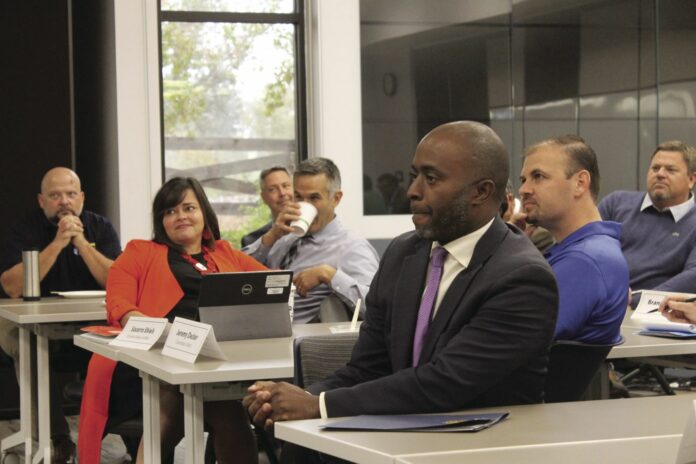
On Nov. 8 State Superintendent of Schools Tony Thurmond and Bruce Harter, deputy state superintendent of operations, sat down with superintendents from all over Sonoma County to discuss the recent disasters.
State leader discusses the roles schools play in disasters and as mental health caretakers
Editor’s note: This is the second of a two-part story. Please check online or in last week’s edition for the first installment, “Thurmond sits down with area’s superintendents.”
On Nov. 8 State Superintendent of Schools Tony Thurmond and Bruce Harter, deputy state superintendent of operations, sat down with superintendents from all over Sonoma County to discuss the recent disasters, including the 2017 fires, the 2018 floods and the recent Kincade Fire, as well as what other things would help in the mission of educating California’s children.
Mental health in schools
The reality of modern education is that the mental health and the social emotional well being of students is now a requirement. However, schools are underfunded, understaffed and generally left to fend for themselves when it comes to providing those services to students.
According to the assembled superintendents, in Sonoma County one in five students have four or more ACEs, or adverse childhood experiences, which create risk factors for everything from depression and suicide, to chronic health issues and academic failure.
“The challenge that goes along with that is that it is really tricky at a school site to be providing therapy, we’re doing triage or maintenance, but that therapy piece is a really, really big challenge,” said one participant.
“Whatever we can do to support counseling and counselors in schools is needed,” agreed Tracy Smith of Rincon Valley.
“I think what’s compounding (all of this) is finding people to fill those roles. We always have unfilled school psychologist and nurse positions. We don’t have the people to fill those positions and that’s another factor I think you have to look at,” said Santa Rosa City School’s Diann Kitamura. “You can have all the greatest plans in the world and all the greatest amounts of money, which we don’t, but we have a shortage of people to actually be on the ground and make these things happen.
“I would (also) think a part of your work would be the cost that we’re all facing in our budgets around special education, because I know providing at a better, higher level for each pupil is something everyone here is interested in,” she added.
There’s also stress on staff to contend with, which adds to issues with retention.
“There are a lot of unfunded mandates coming down and we have very lean district offices, so my person that is doing (California Longitudinal Pupil Achievement Data System) has done the CASEMIS to CALPADS transition and now there’s the monitoring of teachers and the training she has to go to for that and the work that’s piing on and the stress I see that’s on her is part of it,” said Twin Hills’ Barbara Bickford.
While the everyday mental health needs of students is significant, it compounds quickly in the face of disasters, and the fast pace of need doesn’t always match the slow movement of government.
“We did get a few grants to provide counseling and trauma support but typical in government a lot of it is so delayed,” Thurmond said. “I’ve worked with a lot of districts who say, ‘Hey, thanks for the resource but it came so late,’ and we want to ensure you have counselors available in the moment.
“We’re going to be working to bump up our capacity. We’re chasing some grants right now we think might be helpful, but were also leaning on counseling and behavioral health organizations that we think might be able to provide some of their teams when you need to move quickly,” he concluded.
“The other thing we learned (after Tubbs) is that we need to have properly credentialed counselors. We can’t just take children and a family counselor and stick them in a school,” added Sonoma County Superintendent
Steve Herrington.
That slow pace of funding and the specialized needs of the educational environment compound the problems, as do chronic staffing issues.
“We just started seeing the dollars for the fire two years ago,” said Mandy Corbin, assistant superintendent of special education at the Sonoma County Office of Education. “For all 40 districts in the county we have 2.5 (full-time) counselors specially trained in trauma to meet your needs, but those dollars will run out at the end of this year. And though educators don’t want to be responsible for this, they are responsible all the same.”
Part of the issue stems from the disconnect between local mental health organizations and the schools.
“We don’t have any local authority to make our local organizations apply for that grants. We have federal dollars that are meant to help kids but education is not the lead entity on those things,” Corbin said.
“We’re having this conversation in many counties — how we get the county boards of supervisors to free up some of the money from Prop 63. Because that should be available now.”
In addition, Thurmond said Gov. Gavin Newsom had $50 million for school based mental health programs in his budget.
“We’re working with the state’s mental health advisory oversight committee to create the framework for how those dollars get into schools and how they can get to districts and areas that are impacted by emergencies so that we get the resources to communities that need them in a timely way,” Thurmond said.
“Federal dollars have always been given out on a reimbursement basis so you have to go out and spend the money first. In visits with the U.S. Department of Education we’ve asked if we can move into a disbursement system,” Harter added. “So if the application comes in, we would move that money along into school districts. The complication in California is that the legislature has to approve the disbursement of federal dollars, which is something we just learned recently.”
“I don’t know what your mental health agencies are like here in the county but we’re really promoting the districts working in strong partnerships between with mental health organizations in drawing down those Medi-Cal and federal dollars to bring in counselors at our schools,” Thurmond said.
“Our county mental health is currently in the red and is doing layoffs of counselors,” Herrington said dryly. “We’re trying to make sure they don’t use our Prop 63 funds to supplant their shortfall.”
Schools as hubs during disasters
Another big concern expressed by those assembled was the way that schools are expected to be and become the de facto hub of the community during times of disasters. However, districts are not given the corresponding support of other entities for the work that they do.
“I feel there is a crisis in that schools are the only place that are thinking about children during emergencies, but I don’t know that we can bear that given all the educational disparities that we must address,” said Socorro Shiels from Sonoma Valley. “For example, we were asked to staff a shelter. Literally run, not just staff, a shelter for our community and there’s just no way we can do that. When we’re off, its OK, but as soon as schools are coming back online we must pivot to our highest priority, which is educating children.
“I really think there needs to be much more conversation, including topics like mental health, which I know we have to address, but in part we have to address it because nobody else is,” she continued. “We believe strongly in these tools, but it’s also a mistake to put all the pressures only on schools for these services when there are many other players in these areas. It concerns me that in emergencies everyone says oh schools will do it, schools will do it, and we do because we must, but we cannot do that and education.”
“I’ll be blunt. A lot of policy decisions are being made by non-educators who have never been in a classroom and that’s why we get so many unfunded mandates, why we get so many teachers who feel like they get more requirements than they could ever possibly complete in one day and sometimes we’ve allowed our focus to move away from what’s best for education,” Thurmond said. “I’m trying to build a culture that recognizes what your job is. Which is students. The impacts on students has to always be at the center of everything and I just know there are plenty of systems that aren’t about that at all.
“In fact, I just bet when they asked you to manage that shelter they didn’t ask you what do you need in order to do that, they just made an assumption that you could, that you had space and people and didn’t make any assumptions about what your other needs are,” he concluded.
Committee formation
The meeting concluded with a commitment to form an ad hoc committee which will be co-chaired by Mark West’s Ronald Calloway, who experienced loss of school sites, displaced students and families and a host of others challenges in 2017.
Topics to be discussed by the committee include emergency preparation and emergency response, communication strategies between various state and local entities, and how schools can be better included in conversations at the state and local level and be able to articulate their needs.
“I think the ad hoc committee could be a great tool in how we reach districts and then with specificity of the experiences that you’ve had down to the level of certification for the crisis responders and more,” Thurmond said.
Brandon Krueger from Windsor and Chris Vanden Heuvel of Healdsburg were pleased with the meeting and with Thurmond’s plans.
“I think all of our concerns are similar, if not the same, which is what do we do about instructional time lost, what do we do about the social emotional and the post trauma factors,” Krueger said. “I felt reassured just to be able to have that conversation and I think everyone covered what we were thinking about. It was nice to have him listen and I like the idea of having an ad hoc committee so we can help our colleagues in other areas prepare for this.”
“I was impressed he came and three things stood out to me,” agreed Vanden Heuvel. “He was very concerned about loss of instructional time. I really like his equity lens; he’s really in tune with social justice issues in the schools. Last year, when we didn’t even have a fire but the smoke issues occurred that was a huge factor. And there was a lot of conversation in Sonoma County, especially on Facebook, where a lot of parents didn’t necessarily understand that many of our districts, mine for instance and similar in Geyserville, 65% of our students are on free and reduced lunch and have food insecurity.
“We have better HVAC systems and better capacity to serve those kids and those kids are better off in school
Last year, when we didn’t even have a fire but the smoke issues occurred that was a huge factor. And there was a lot of conversation in Sonoma County, especially on Facebook, where a lot of parents didn’t necessarily understand that many of our districts, mine for instance and similar in Geyserville, 65% of our students are on free and reduced lunch and have food insecurity.
“We have better HVAC systems and better capacity to serve those kids and those kids are better off in school than at home, even when it’s smoky,” he continued. “So I appreciated that, and the (discussion about) mental health issues and supports.”








